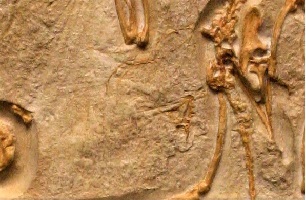Archaeopteryx (meaning "old wing") - The London specimen was the first Archaeopteryx to be described and was found, in a section of the Community Quarry at Solnhofen which belonged to Johann Freidrich Ottman, near Langenaltheim, Germany in 1861. It was given to a physician, Karl Haberlein, most likely for medical services rendered. The doctor sold it to the London Natural History Museum for 700 pounds sterling. The price also included 1756 other Solnhofen specimens (many were rare and as yet to be described).
The London specimen was first described by Andreas Wagner, of Germany, in 1862. The description of the fossil was made even though all he had was a drawing made by Albert Oppel, the director of the State Paleontological Collection in Munich. He described the feather imprints to resemble those of a true bird and the tail resembled that of a Ramphorhynchus. In spite of the feather like imprints he did consider the specimen a reptile. His reasoning was likely due to his anti-Darwinian approach to paleontology. He was very uncomfortable with the concept that a "transitional fossil" could exist and that there was no room for an intermediate form to exist between reptiles and birds.
Richard Owen of the Natural History Museum of London, is credited with giving the first historical description having studied the actual specimen, in 1862. In his description, Owen missed the upper jaw fragments, located further to the left of the skeleton. Henry Woodward, who was an assistant at the Geological Department of the British Museum published a short article on the specimen in December 1862. It was this article that fanned interest in the specimen across Europe.
The Solnhofen beds have long been mined for their fine grained limestone which is perfect for lithographic printing. These Late Jurassic beds are also renowned for producing marine and terrestrial animal and plant fossils of exquisite preservation. During the Late Jurassic, the Bavarian region of Germany was a series of islands and coastal logoons. Any creatures remains that were washed into one of these lagoons would lay undisturbed and unscavanged. Layers of fine marine sediment would cover the remains, leading to nearly flawless preservation.
Archaeopteryx lithographica - London specimen 
Quantity in Basket: None
Code: AVE-102
Price: $270.50
Shipping Weight: 5.21 pounds
Dimensions: 22" x 17-1/8" x 1-1/8"